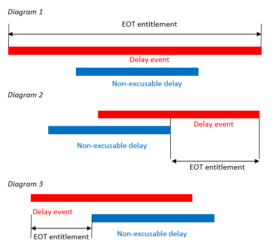UK decision on concurrent delay: Chicken or the egg/roof or frame, what had to happen first?
Market Insights
A seemingly simple question of whether works to the roof or the steel frame of a building drove the critical path produced an almost intractable “chicken or egg” like conundrum in this decision on 17 October 2022 of the High Court of England and Wales (Technology and Construction Court) in Thomas Barnes & Sons Plc v Blackburn with Darwen Borough Council [2022] EWHC 2598.
This decision will benefit contractors claiming EOTs. Principals and superintendents contemplating whether to reject such claims should take note of the Court’s alternative approach to concurrency. This paper distils some key points, but we leave to the experts the question of what came first, the chicken or the egg.
Executive Summary
The decision involved the all too familiar scenario in delay disputes of competing expert evidence on delay methodologies and concurrency.
The key takeaways from this decision are:
- Delay experts are not required to slavishly apply a particular delay methodology in the manner set out in the SCL Protocol. The latter is a guide and not a prescribed code. Experts may deviate from a methodology described in the SCL Protocol if a proper explanation for doing so is provided. This position is no different to the position in Australia;
- Where there is concurrent delay, the default position (absent any contract wording to the contrary) is likely to be that a contractor will be entitled to the additional time regardless of concurrency but not money. Many contracts, including the Australian standards, alter this default position so that the entitlements are aligned, i.e., delay damages are only recoverable to the extent there is an EOT;
- The SCL Protocol endorses a “first in time” approach to render irrelevant a concurrent delay that is eclipsed by another critical delay. Courts may disregard this approach and award an EOT if it produces a result that defies common sense. The same could be the case, if, as we respectfully suggest, this was not a true first in time scenario, but simply one in which two concurrent delays commenced at the same time and where the claimed delay ended before the concurrent delay. Even so, in that scenario, based on the common sense approach deployed by the Court, a contractor may still have an EOT claim; and
- There is much to be said for a common sense approach but it undermines certainty in an area already rife with uncertainty. We respectfully suggest that it should only apply in circumstances similar to those in this decision where the concurrent delay ending after the claimed delay had float and the Contractor was not responsible for critical successor activities to the claimed delay. We do not think those circumstances will be that uncommon and so this is a decision that contractors and principals should take note of.
What happened?
The contractor, Thomas Barnes & Sons Plc (Contractor), was engaged to construct a bus terminal in Blackburn, United Kingdom by Blackburn and Darwen Borough Council (Principal).
The striking design of the bus station comprised a hub area at one end (“the hub”), providing office space on the ground and mezzanine first floor levels, with the rest of the structure comprising the concourse (“the concourse”) affording waiting space and access to buses. Frameless external glazing running from the floor to the ceiling encased the whole structure.

Delays occurred to the internal finishes of the first floor of the offices at the hub end of the structure, as depicted below, which delayed the date of practical completion.

The contract was terminated by the Principal and the Contractor went into administration. The administrators commenced proceedings claiming, amongst other things, extensions of time and prolongation costs. The parties were at odds as to the correct delay methodology and whether the Contractor’s extensions of time and prolongation cost claims were reduced by concurrent delays for which it was responsible.
Delay methodology
The contract did not prescribe a particular methodology. It permitted the contract administrator to grant an EOT where completion “has been or is likely to be delayed by a ‘relevant event’”.1 In Australia, this wording entitles the superintendent or the court to adopt either a prospective or retrospective methodology.2
The Contractor’s expert, Mr Hudson, adopted a retrospective “as-planned versus as-built windows analysis”, and the Principal’s expert, Mr Gunton, a hybrid time slice windows analysis and time impact analysis.
The Principal invited the court to treat the evidence given by Mr Hudson with circumspection on the following basis:
(a) he had failed to follow the specific guidance given in the Delay and Disruption Protocol published by the Society of Construction Law, 2nd Edition; February 2017 (the SCL Protocol) in relation to the “as-planned versus as-built windows analysis” method; and
(b) he had produced an overly-simplified analysis based on a “retrospective longest path analysis” method, which failed to investigate and engage with all of the potential causes of delay to the critical path of the works.
The Contractor, in turn, argued Mr Gunton’s hybrid approach was flawed by conflating a prospective and a retrospective approach to critical path analysis and by being unduly reliant on computer modelling when what was really required was a close focus on actual events.
His Honour Judge Stephen Davies held at [110], “it would be wrong to proceed on the basis that, because the SCL Protocol identifies six commonly used methods of delay analysis, an expert is only allowed to choose one such method and any deviation from that stated approach renders their opinion fundamentally unreliable”. This he qualified by holding “if an expert selects a method which is manifestly inappropriate for the particular case, or deviates materially from the method which he has said he is following, without providing any, or any proper, explanation, that can be a material consideration in deciding how much weight to place on the opinions expressed by the expert”.
This approach is consistent with the position in Australia. In the NSW Supreme Court decision of White Constructions Pty Ltd v PBS Holdings Pty Ltd [2019] NSWSC 1166 Hammerschlag J held at [191] that “the fact that a method appears in the Protocol does not give it any standing, and the fact that a method, which is otherwise logical or rational, but does not appear in the Protocol, does not deny it standing”.
In this case, it was not the choice of methodology that appears decisive but rather the manner in which it was deployed. In our experience, a strict application of a particular methodology is not often what is required and delay experts are adept at resolving issues such as this by modifying approaches to give effect to the contractual requirements.3
The Court considered that Mr Hudson had produced an overly-simplified “as-planned versus as-built windows analysis” which failed to investigate and engage with all potential causes of delay to the critical path. In particular, it agreed with Mr Gunton’s evidence that by measuring only the movement of a specific activity from the as-planned to the as-built date, Mr Hudson had failed to take into account the progress and performance of other critical building activities, and specifically, as discussed below, concurrent critical delay to the roof covering for which the Contractor was responsible.
Concurrency – a few general principles
Keating on Construction Contracts 11th edition (Keating)4 sets out the general principle under English law that, subject to the wording of the contract, a contractor:
a) is probably entitled to an extension of time if the event relied upon was an effective cause of delay even if there was another concurrent cause of the same delay in respect of which the contractor was contractually responsible; and
b) is only entitled to recover loss and expense where it satisfies the “but for” test. Thus, even if the event relied upon was the dominant cause of the loss, the contractor will fail if there was another cause of that loss for which the contractor was contractually responsible. (Keating approach).5
The usual effect of this approach is that where there is a concurrent delay for which the contractor is responsible, a contractor is still entitled to additional time arising from an excusable delay but not to additional money. In Australia, contracts often amend this risk allocation by aligning the entitlements such that the contractor receives neither time nor money in the event of non-excusable concurrent delays.6
The starting point of any enquiry is to determine whether there is any concurrent delay in the first place. This usually involves an analysis of whether the concurrent activities sit on the critical path, being the longest sequence of activities that are essential or critical to achieve practical completion. Numerous tests have been applied over the years to answer this question of whether relevant concurrent delay exists or not:
a) A simple “but for” test asks: but for the delay event, would practical completion have been delayed in any event by reason of other delays? If the answer is ‘‘no’’, then the event is said to have caused the delay to practical completion. This test can produce illogical results.7 For example, if two independent events were sufficient to cause the delay, the ‘‘but for’’ test could result in the absurd conclusion that neither event caused the delay; and
b) The “first in time” approach: if an event has already caused a delay to the completion date, a subsequent delaying event must then be disregarded, unless that further extends the completion beyond the original consequences of the first delay event (first in time approach). The first in time approach is recommended in the SCL Protocol and has been referred to in relatively recent decisions in the UK.8 It can be explained in Diagrams 1-3 of Fig 1 below; and

Fig 1 – Concurrency diagrams based on the first in time approach
c) The “dominant cause” or “common sense” approach, involves a qualitative question of whether two delaying events were of “equal causative potency”, notwithstanding that one of them may not impact the critical path. The “dominant cause” approach is similar to the “common sense” test applied in Australia, as propounded in March v M H Stramare Pty Ltd,9 and, generally, courts tend to use expressions such as ‘‘effective or dominant’’ cause as code for determining whether, as a matter of common sense, the relevant event caused the delay. For the purposes of this article, we refer to this approach as the common sense approach.
Concurrent delays in this case
The concurrent delays in issue were the following:
a) delay to the internal finishes caused by a hub steelwork deflection issue, a Principal risk event (steelwork deflection delay); and
b) delay to the roof covering, a Contractor risk, required to render the structure watertight, which delayed the internal finishes (roof covering delay).
The internal finishes were on the critical path to completion and so both delays were said to be critical.
The Contractor’s expert, Mr Hudson, argued that the roof covering delay was not a relevant concurrent delay because the steelwork deflection delay commenced before and ended after the roof covering delay. Sufficient float was created for the roof covering delay such that it had no impact on practical completion. Mr Hudson argued that any delay in the roof covering activities was “pacing”.
Mr Hudson’s argument reflects the first in time approach discussed above. It is effectively represented in Diagram 1 of Fig 1.
Decision
Consistent with the Keating approach, the Court found that, due to the steel deflection delay, the Contractor was entitled to an EOT of 119 days for the period between 4 October 2014 to 1 February 2015 (less periods of culpable delay) notwithstanding the concurrent delay due the roof covering issue.
In relation to prolongation costs, which involved a consideration of concurrency, the Court found that the steel deflection delay only became critical at a later point in time (9 December 2014) when float for this activity was consumed. This resulted in a shorter period of compensable delay as represented in Diagram 2 in Fig 1 above.
The Court’s conclusion that the Contractor was entitled to an EOT from 4 October 2014 is difficult to reconcile with its finding that the steel deflection issue only became critical on 9 December 2014. In our view, even on the Keating approach, the Contractor should have only been entitled to an EOT from 9 December 2014 when the steel deflection issue became critical.
In relation to the allegation that the roof covering delay was not critical as it had float, the Court found that the roof covering delay was not a ‘pacing’ delay. At [133], the Court found:
If [Mr Hudson] meant to suggest that the roof coverings could have been progressed but they were non-critical and could have been performed in a more leisurely manner as a result, this seems to me to ignore the fundamental fact that throughout the crucial period from October 2014 through to January 2015 the claimant could not have known how long the remedial works to the hub steelworks would take and could not therefore reasonably have proceeded on the basis that there was no need to worry about the roof coverings until the hub steel deflection issue was completely resolved.
In summary, the Court considered that the question of any pacing needs to be assessed at the time of the relevant delay and not with the benefit of hindsight.
In deciding that the roof covering delay was a relevant concurrent delay notwithstanding that it appeared to be eclipsed by the steel deflection issue (and therefore did not impact the critical path), His Honour appeared to ignore the first in time approach in favour of the common sense test referred to above.
At [140], the Court held:
In my judgment this is a case where these causes were concurrent over the period of delay caused by the roof coverings. That is because completion of the remedial works to the hub structural steelwork was essential to allow the concrete topping to be poured and the hub SFS to be installed, without which the hub finishes could not be meaningfully started, but completion of the roof coverings was also essential for the hub finishes to be meaningfully started as well. It is not enough for the claimant to say that the works to the roof coverings were irrelevant from a delay perspective because the specification and execution of the remedial works to the hub structural steelwork were continuing both before and after that period of delay. Conversely, it is not enough for the defendant to say that the remedial works to the hub structural steelwork were irrelevant from a delay perspective because the roof coverings were on the critical path. The plain fact is that both of the works items were on the critical path as regards the hub finishes and both were causing delay over the same period.
(emphasis added)
Although the Court did not consider the authorities that support the first in time approach or the SCL Protocol,10 the emphasised passage above appears to be an express rejection of the approach.
At [143] and [144], His Honour held:
Even if there had been no delay to the roof coverings the hub finishes, which it is agreed were on the critical path, could not have started earlier because of the delay to the remedial works to the hub structural steelwork.
I am also satisfied that the converse is also true. The claimant cannot simply say that because there was a problem with the hub structural steelwork identified in October 2014, which was not finally resolved until January 2015, all of the delay between those points in time was only caused by this cause. It ignores the fact that for a very considerable period of time there was also a problem caused by the delay to the roof coverings which was itself a cause of delay to the critical path.
Should the Court have applied a common sense approach?
We respectfully contend that, subject to qualifications below, a common sense test was justified, but perhaps not for the reasons set out in the decision.
We have summarised below our understanding of the relevant sequence, acknowledging that more information may have been available to the Court and the experts than appears in the judgment.11

Fig 2 – Sequence based on identifiable facts in the judgement
It can be seen from the above that the case appears to be the opposite of that put by the Claimant (as referred to by the Court in the emphasised passage from paragraph [140] above), where the steelwork deflection delay was said to start before and end after the roof covering delay.
More importantly, since an EOT had already been granted for the period of the steelwork deflection delay up to 3 October 2014, the relevant periods of the roof and steelwork deflection delay commenced at the same time on 4 October 2014.12 In short, the case does not appear to be a first in time scenario at all.
Rather, the facts suggest that this was simply a case in which there was no net Principal caused delay in favour of the Contractor (because the steelwork deflection delay ended before the roof covering delay). Ordinarily, a contractor would receive nothing by way of EOT entitlements.13 However, a common sense approach appears to have been deployed to still afford the Contractor a claim for the period of the steelwork deflection delay (or at least from 9 December 2014 when the steelwork deflection delay first became critical).
This may be surprising to some. In our view, it can only be justified on the basis that although float in the roof covering activity did not render it irrelevant as a concurrent delay, the plain fact is that completion of the steelwork deflection delay was necessary for critical successor activities (concrete topping and hub SFS), i.e., the internal finishes could not commence any earlier regardless of the longer duration of the roof covering delay.
This justification would fall away if the Contractor was responsible for successor activities to the steelwork deflection delay, in particular the hub SFS works (Activity 5), which appears to have taken 72 days more than the 5 days planned.14
Conclusion
While there is merit in a common sense approach, it does not provide much certainty to the parties in an area that is already rife with uncertainty. The approach should, therefore, be applied with caution. The first in time approach is still favoured in the SCL protocol and in relatively recent decisions in the UK,15 which the Court did not expressly consider. Even if this was not, in fact, a first in time case, the same caution should be exercised when applying a common sense approach to sequences similar to that depicted in Fig 2 above, ie where there was no net Principal caused delay in favour of the Contractor. Only if the Contractor was not responsible for critical successor activities, is this approach really justified.
It is unclear whether a court would apply the same approach if faced with a contract that excludes an EOT to the extent of any concurrent overlapping delay (as many contracts do). The result may be the same where concurrency clauses generally still leave open the question of causation and therefore the possibility of a common sense test.
Delay experts will no doubt find this case fascinating, and it is likely to provoke debate and discussion. Delay disputes on large projects are time consuming and expensive to run. Many do not go the distance and, consequently, there are only a limited number of reported decisions in Commonwealth jurisdictions from which practitioners in this space can seek guidance. This decision offers insights into the way in which courts approach complex and often highly contested issues such as the appropriate delay methodology, the correct critical path and concurrency.
Perhaps we are at the stage where more thought should be given up front and in the contract about the delay methodology to be adopted for assessment of EOT, and which concurrency test is to be applied. Whilst this approach is also fraught with risk, perhaps it is time that we have the debate at the front end, rather than many years after the fact.
This article was written by Brian Rom, Special Counsel and reviewed by Theo Kalyvas, Partner.
1 See [74]
2 Built Qld Pty Ltd v Pro-invest Australian Hospitality Opportunity (St) Pty Ltd [2022] QCA 266 (Built), [106] to [117]
3 See our previous note on Built dated 26 January 2023 and the Court of Appeal’s comment that for a prospective / time impact analysis, it is possible to perform additional steps which take into account later history
4 Keating on Construction Contracts 11th edition at 9-105
5 At [118] referring to De Beers v Atos Origin IT Services UK Ltd [2011] BLR 274 at [177]; Adyard Abu Dhabi v SD Marine Services [2011] EWHC 848 Comm at [277] and Walter Lilly & Company Ltd v Mckay [2012] EWHC 1773 at [366] to [370] and Henry Boot Construction (UK) Ltd v Malmaison Hotel (Manchester) Ltd (1999) 70 Con LR 32 at [13]
6 See for example clause 34.9 of AS 4000-1997. A contractually agreed risk allocation is generally upheld; see North Midland Building Ltd v Cyden Homes Ltd [2018] EWCA Civ 1744
7 March v M H Stramare Pty Ltd (1991) 171 CLR 506, 522-523 per Deane J
8 See SCL Delay and Disruption Protocol 2nd Edition; February 2017, paragraphs 10.7 to 10.10 and Royal Brompton Hospital NHS Trust v Hammond (No 7) (2001) 76 Con LR 148 at [31] also referred to in Saga Cruises BDF Ltd & Anor v Fincantieri SPA [2016] EWHC 1875 (Comm) (29 July 2016) at [242] and Dhabi v Sd Marine Services [2011] EWHC 848 (Comm) (11 April 2011) at [278]
9 [1] See fn 7
10 See fn 8
11 The diagram is provided courtesy of Ian Thorpe of E3 Advisory with the same caveat that further information may have been available to the Court and the experts than is apparent from the decision.
12 See [122]
13 Subject to the Keating approach and the terms of the contract
14 Mr Gunton appears to have accepted that the Principal was responsible for some of this delay. Had the hub SFS works been completed in the original time frame of 5 days, the steelwork deflection delay would have caused no critical delay at all. The hub SFS would have been completed on 12 February 2014 but no work could have commenced on the internal finishes until the work on the roof covering was complete on 23 February 2013
15 fn 8
Subscribe for publications + events
HWLE regularly publishes articles and newsletters to keep our clients up to date on the latest legal developments and what this means for your business. To receive these updates via email, please complete the subscription form and indicate which areas of law you would like to receive information on.
* indicates required fields

